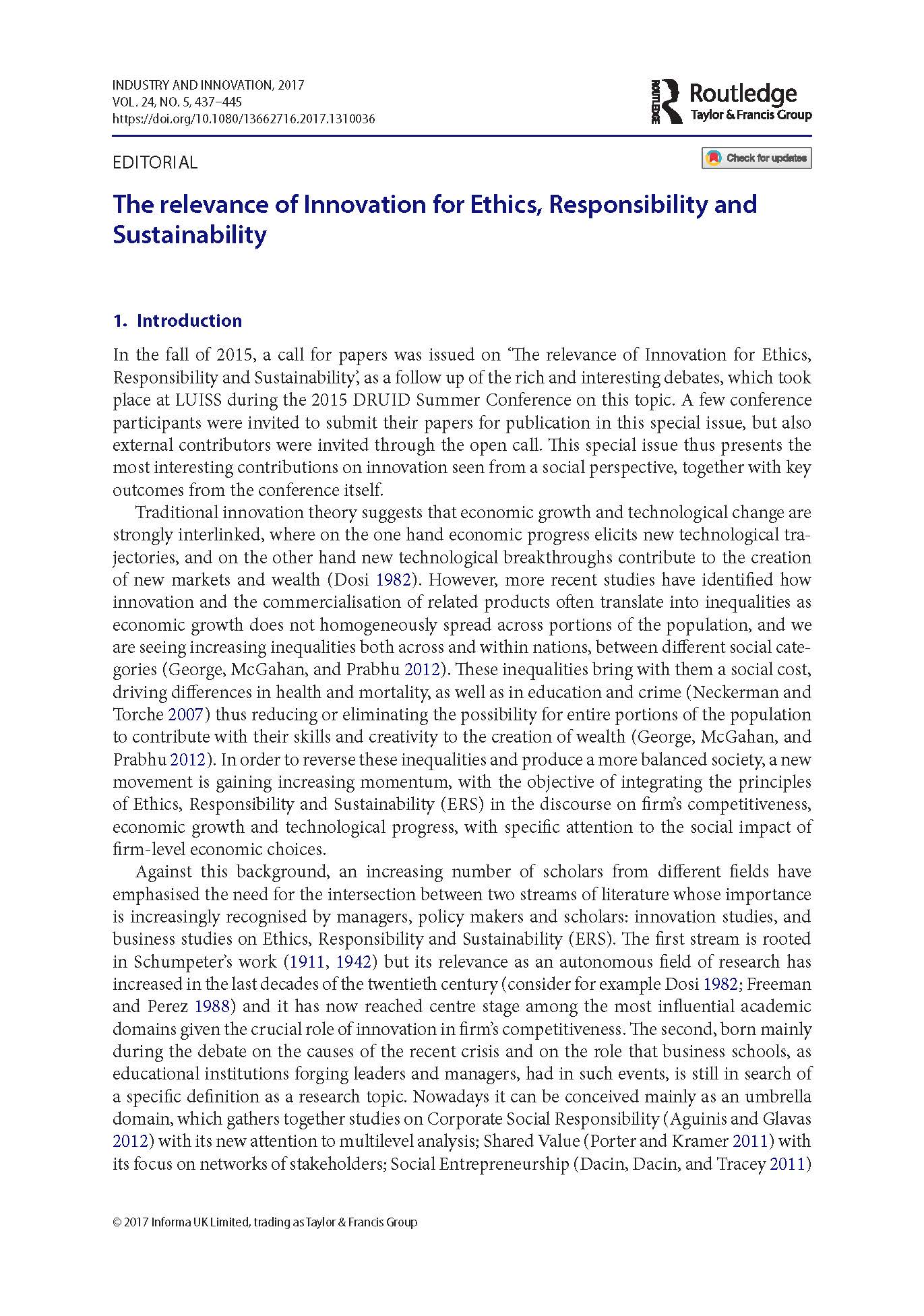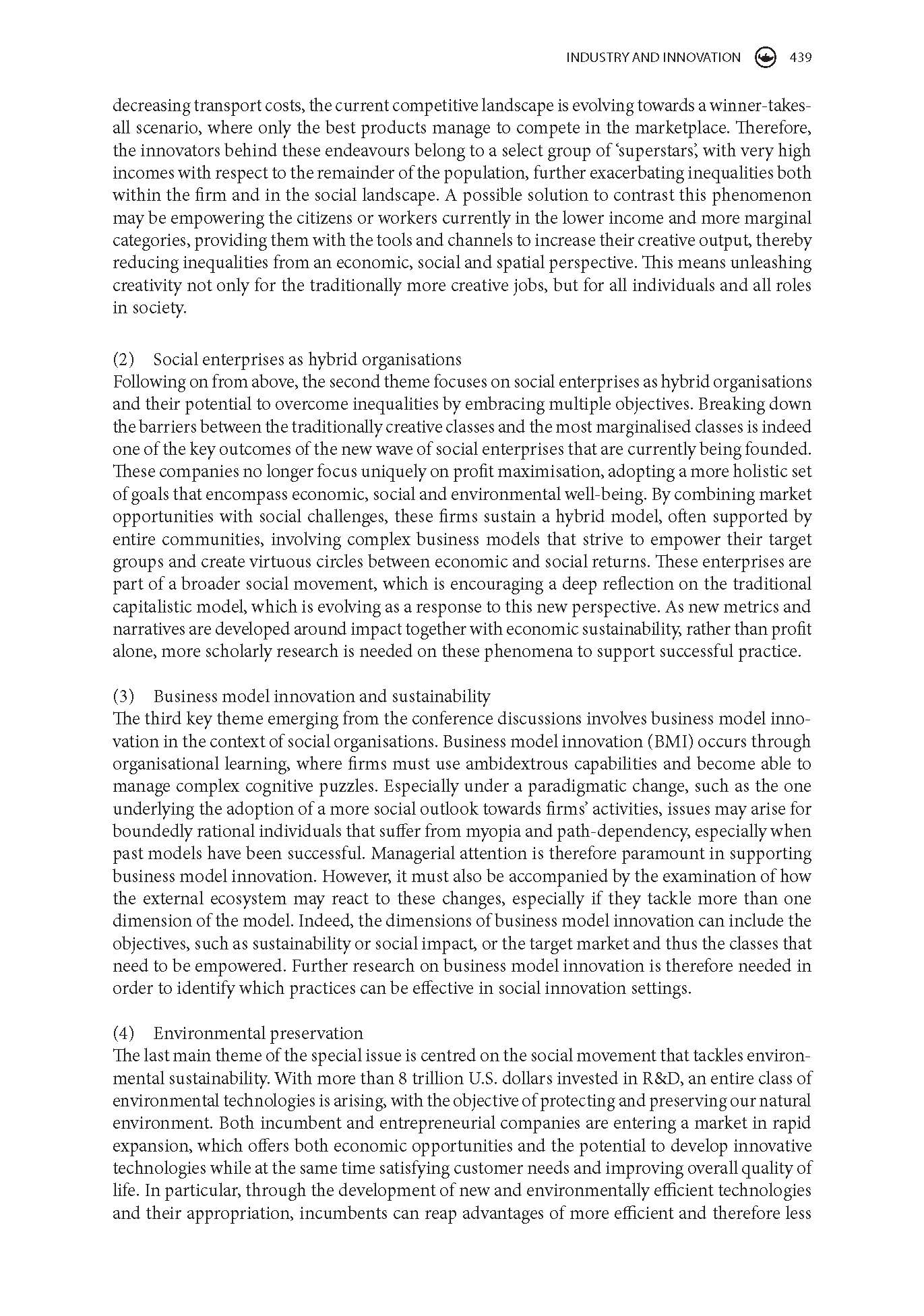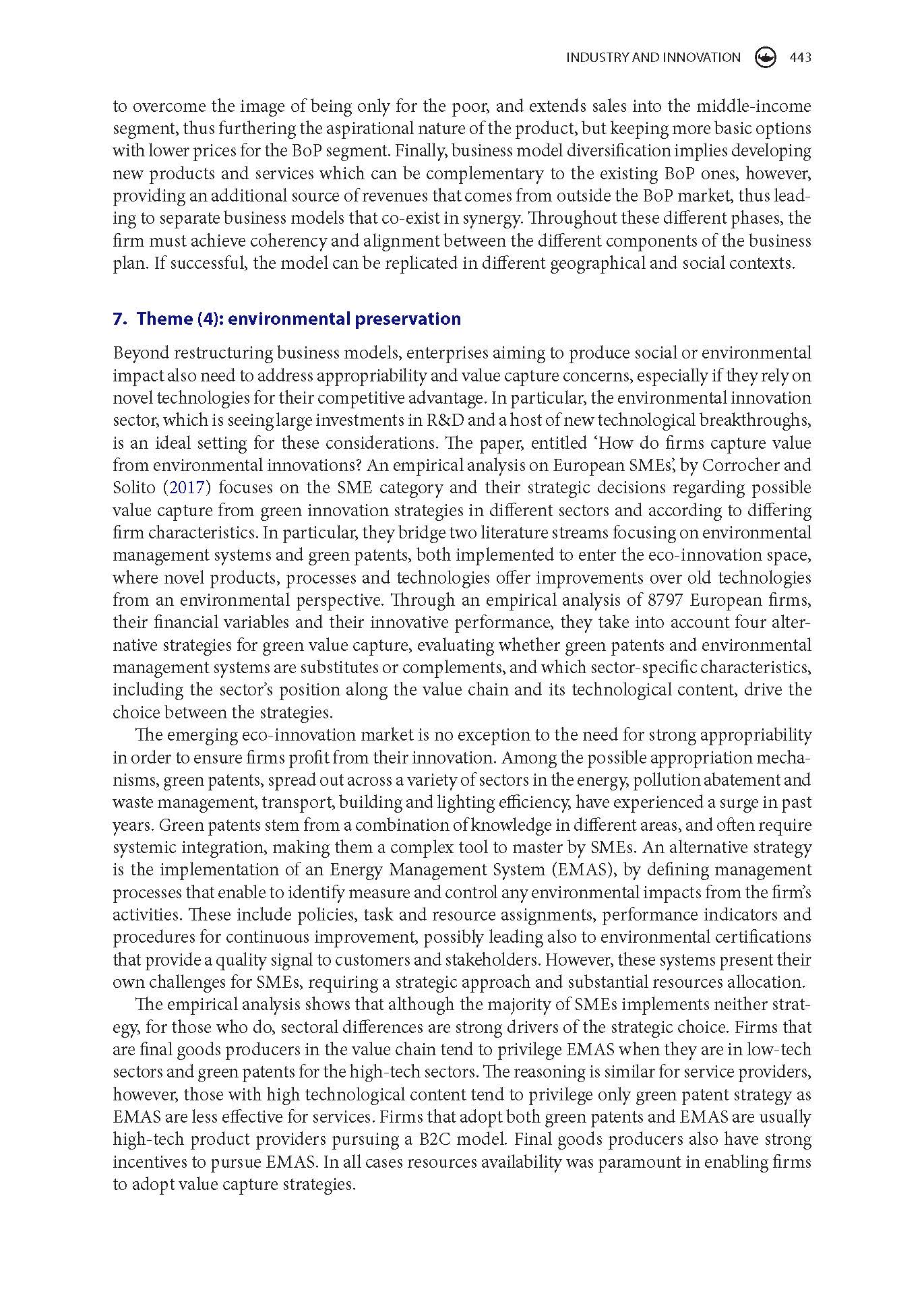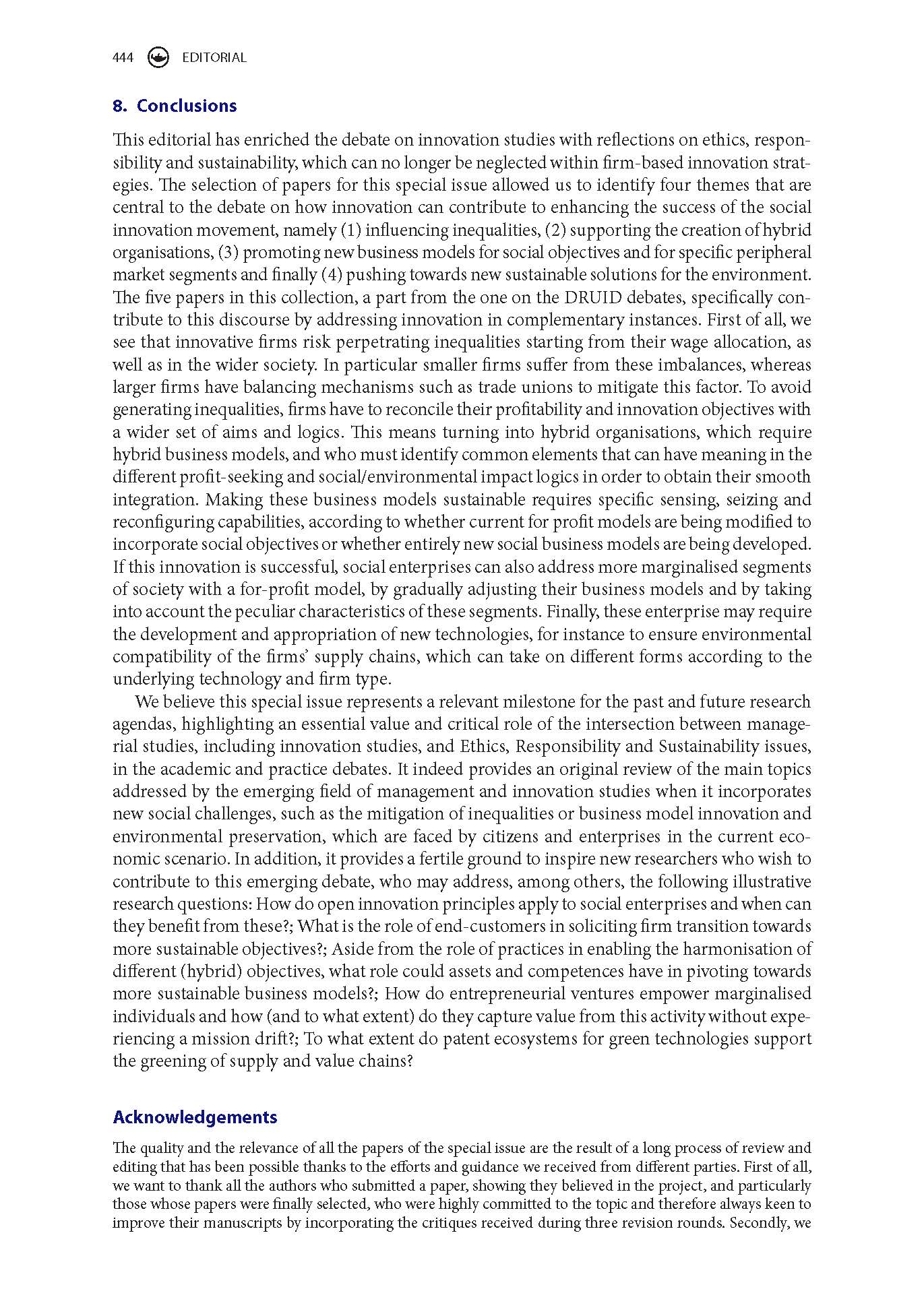Review the themes and summaries of the special issue in the attached article The Relevance of Innovation for Ethics , Responsibilities and Sustainability.
- What ethical frameworks are inherent among the summaries of papers/topics/themes?
- Which ethical framework do you think applies to sustainability and innovation?




The relevance of Innovation for Ethics, Responsibility and Sustainability 1. Introduction In the fall of 2015, a call for papers was issued on "The relevance of Innovation for Ethics, Responsibility and Sustainability, as a follow up of the rich and interesting debates, which took place at LUISS during the 2015 DRUID Summer Conference on this topic. A few conference participants were invited to submit their papers for publication in this special issue, but also external contributors were invited through the open call. This special issue thus presents the most interesting contributions on innovation seen from a social perspective, together with key outcomes from the conference itself. Traditional innovation theory suggests that economic growth and technological change are strongly interlinked, where on the one hand economic progress elicits new technological trajectories, and on the other hand new technological breakthroughs contribute to the creation of new markets and wealth (Dosi 1982). However, more recent studies have identified how innovation and the commercialisation of related products often translate into inequalities as economic growth does not homogeneously spread across portions of the population, and we are seeing increasing inequalities both across and within nations, between different social categories (George, McGahan, and Prabhu 2012). These inequalities bring with them a social cost, driving differences in health and mortality, as well as in education and crime (Neckerman and Torche 2007) thus reducing or eliminating the possibility for entire portions of the population to contribute with their skills and creativity to the creation of wealth (George, McGahan, and Prabhu 2012). In order to reverse these inequalities and produce a more balanced society, a new movement is gaining increasing momentum, with the objective of integrating the principles of Ethics, Responsibility and Sustainability (ERS) in the discourse on firm's competitiveness, economic growth and technological progress, with specific attention to the social impact of firm-level economic choices. Against this background, an increasing number of scholars from different fields have emphasised the need for the intersection between two streams of literature whose importance is increasingly recognised by managers, policy makers and scholars: innovation studies, and business studies on Ethics, Responsibility and Sustainability (ERS). The first stream is rooted in Schumpeter's work (1911,1942) but its relevance as an autonomous field of research has increased in the last decades of the twentieth century (consider for example Dosi 1982; Freeman and Perez 1988) and it has now reached centre stage among the most influential academic domains given the crucial role of innovation in firm's competitiveness. The second, born mainly during the debate on the causes of the recent crisis and on the role that business schools, as educational institutions forging leaders and managers, had in such events, is still in search of a specific definition as a research topic. Nowadays it can be conceived mainly as an umbrella domain, which gathers together studies on Corporate Social Responsibility (Aguinis and Glavas 2012) with its new attention to multilevel analysis; Shared Value (Porter and Kramer 2011) with its focus on networks of stakeholders; Social Entrepreneurship (Dacin, Dacin, and Tracey 2011) INDUSTRY AND INNOVATION 439 decreasing transport costs, the current competitive landscape is evolving towards a winner-takesall scenario, where only the best products manage to compete in the marketplace. Therefore, the innovators behind these endeavours belong to a select group of 'superstars', with very high incomes with respect to the remainder of the population, further exacerbating inequalities both within the firm and in the social landscape. A possible solution to contrast this phenomenon may be empowering the citizens or workers currently in the lower income and more marginal categories, providing them with the tools and channels to increase their creative output, thereby reducing inequalities from an economic, social and spatial perspective. This means unleashing creativity not only for the traditionally more creative jobs, but for all individuals and all roles in society. (2) Social enterprises as hybrid organisations Following on from above, the second theme focuses on social enterprises as hybrid organisations and their potential to overcome inequalities by embracing multiple objectives. Breaking down the barriers between the traditionally creative classes and the most marginalised classes is indeed one of the key outcomes of the new wave of social enterprises that are currently being founded. These companies no longer focus uniquely on profit maximisation, adopting a more holistic set of goals that encompass economic, social and environmental well-being. By combining market opportunities with social challenges, these firms sustain a hybrid model, often supported by entire communities, involving complex business models that strive to empower their target groups and create virtuous circles between economic and social returns. These enterprises are part of a broader social movement, which is encouraging a deep reflection on the traditional capitalistic model, which is evolving as a response to this new perspective. As new metrics and narratives are developed around impact together with economic sustainability, rather than profit alone, more scholarly research is needed on these phenomena to support successful practice. (3) Business model innovation and sustainability The third key theme emerging from the conference discussions involves business model innovation in the context of social organisations. Business model innovation (BMI) occurs through organisational learning, where firms must use ambidextrous capabilities and become able to manage complex cognitive puzzles. Especially under a paradigmatic change, such as the one underlying the adoption of a more social outlook towards firms' activities, issues may arise for boundedly rational individuals that suffer from myopia and path-dependency, especially when past models have been successful. Managerial attention is therefore paramount in supporting business model innovation. However, it must also be accompanied by the examination of how the external ecosystem may react to these changes, especially if they tackle more than one dimension of the model. Indeed, the dimensions of business model innovation can include the objectives, such as sustainability or social impact, or the target market and thus the classes that need to be empowered. Further research on business model innovation is therefore needed in order to identify which practices can be effective in social innovation settings. (4) Environmental preservation The last main theme of the special issue is centred on the social movement that tackles environmental sustainability. With more than 8 trillion U.S. dollars invested in R\&D, an entire class of environmental technologies is arising, with the objective of protecting and preserving our natural environment. Both incumbent and entrepreneurial companies are entering a market in rapid expansion, which offers both economic opportunities and the potential to develop innovative technologies while at the same time satisfying customer needs and improving overall quality of life. In particular, through the development of new and environmentally efficient technologies and their appropriation, incumbents can reap advantages of more efficient and therefore less to overcome the image of being only for the poor, and extends sales into the middle-income segment, thus furthering the aspirational nature of the product, but keeping more basic options with lower prices for the BoP segment. Finally, business model diversification implies developing new products and services which can be complementary to the existing BoP ones, however, providing an additional source of revenues that comes from outside the BoP market, thus leading to separate business models that co-exist in synergy. Throughout these different phases, the firm must achieve coherency and alignment between the different components of the business plan. If successful, the model can be replicated in different geographical and social contexts. 7. Theme (4): environmental preservation Beyond restructuring business models, enterprises aiming to produce social or environmental impact also need to address appropriability and value capture concerns, especially if they rely on novel technologies for their competitive advantage. In particular, the environmental innovation sector, which is seeinglarge investments in R\&D and a host of new technological breakthroughs, is an ideal setting for these considerations. The paper, entitled 'How do firms capture value from environmental innovations? An empirical analysis on European SMEs', by Corrocher and Solito (2017) focuses on the SME category and their strategic decisions regarding possible value capture from green innovation strategies in different sectors and according to differing firm characteristics. In particular, they bridge two literature streams focusing on environmental management systems and green patents, both implemented to enter the eco-innovation space, where novel products, processes and technologies offer improvements over old technologies from an environmental perspective. Through an empirical analysis of 8797 European firms, their financial variables and their innovative performance, they take into account four alternative strategies for green value capture, evaluating whether green patents and environmental management systems are substitutes or complements, and which sector-specific characteristics, including the sector's position along the value chain and its technological content, drive the choice between the strategies. The emerging eco-innovation market is no exception to the need for strong appropriability in order to ensure firms profit from their innovation. Among the possible appropriation mechanisms, green patents, spread out across a variety of sectors in the energy, pollution abatement and waste management, transport, building and lighting efficiency, have experienced a surge in past years. Green patents stem from a combination of knowledge in different areas, and often require systemic integration, making them a complex tool to master by SMEs. An alternative strategy is the implementation of an Energy Management System (EMAS), by defining management processes that enable to identify measure and control any environmental impacts from the firm's activities. These include policies, task and resource assignments, performance indicators and procedures for continuous improvement, possibly leading also to environmental certifications that provide a quality signal to customers and stakeholders. However, these systems present their own challenges for SMEs, requiring a strategic approach and substantial resources allocation. The empirical analysis shows that although the majority of SMEs implements neither strategy, for those who do, sectoral differences are strong drivers of the strategic choice. Firms that are final goods producers in the value chain tend to privilege EMAS when they are in low-tech sectors and green patents for the high-tech sectors. The reasoning is similar for service providers, however, those with high technological content tend to privilege only green patent strategy as EMAS are less effective for services. Firms that adopt both green patents and EMAS are usually high-tech product providers pursuing a B2C model. Final goods producers also have strong incentives to pursue EMAS. In all cases resources availability was paramount in enabling firms to adopt value capture strategies. 8. Conclusions This editorial has enriched the debate on innovation studies with reflections on ethics, responsibility and sustainability, which can no longer be neglected within firm-based innovation strategies. The selection of papers for this special issue allowed us to identify four themes that are central to the debate on how innovation can contribute to enhancing the success of the social innovation movement, namely (1) influencing inequalities, (2) supporting the creation of hybrid organisations, (3) promoting new business models for social objectives and for specific peripheral market segments and finally (4) pushing towards new sustainable solutions for the environment. The five papers in this collection, a part from the one on the DRUID debates, specifically contribute to this discourse by addressing innovation in complementary instances. First of all, we see that innovative firms risk perpetrating inequalities starting from their wage allocation, as well as in the wider society. In particular smaller firms suffer from these imbalances, whereas larger firms have balancing mechanisms such as trade unions to mitigate this factor. To avoid generating inequalities, firms have to reconcile their profitability and innovation objectives with a wider set of aims and logics. This means turning into hybrid organisations, which require hybrid business models, and who must identify common elements that can have meaning in the different profit-seeking and social/environmental impact logics in order to obtain their smooth integration. Making these business models sustainable requires specific sensing, seizing and reconfiguring capabilities, according to whether current for profit models are being modified to incorporate social objectives or whether entirely new social business models are being developed. If this innovation is successful, social enterprises can also address more marginalised segments of society with a for-profit model, by gradually adjusting their business models and by taking into account the peculiar characteristics of these segments. Finally, these enterprise may require the development and appropriation of new technologies, for instance to ensure environmental compatibility of the firms' supply chains, which can take on different forms according to the underlying technology and firm type. We believe this special issue represents a relevant milestone for the past and future research agendas, highlighting an essential value and critical role of the intersection between managerial studies, including innovation studies, and Ethics, Responsibility and Sustainability issues, in the academic and practice debates. It indeed provides an original review of the main topics addressed by the emerging field of management and innovation studies when it incorporates new social challenges, such as the mitigation of inequalities or business model innovation and environmental preservation, which are faced by citizens and enterprises in the current economic scenario. In addition, it provides a fertile ground to inspire new researchers who wish to contribute to this emerging debate, who may address, among others, the following illustrative research questions: How do open innovation principles apply to social enterprises and when can they benefit from these?; What is the role of end-customers in soliciting firm transition towards more sustainable objectives?; Aside from the role of practices in enabling the harmonisation of different (hybrid) objectives, what role could assets and competences have in pivoting towards more sustainable business models?; How do entrepreneurial ventures empower marginalised individuals and how (and to what extent) do they capture value from this activity without experiencing a mission drift?; To what extent do patent ecosystems for green technologies support the greening of supply and value chains? Acknowledgements The quality and the relevance of all the papers of the special issue are the result of a long process of review and editing that has been possible thanks to the efforts and guidance we received from different parties. First of all, we want to thank all the authors who submitted a paper, showing they believed in the project, and particularly those whose papers were finally selected, who were highly committed to the topic and therefore always keen to improve their manuscripts by incorporating the critiques received during three revision rounds. Secondly, we










